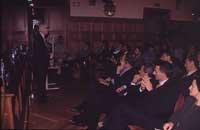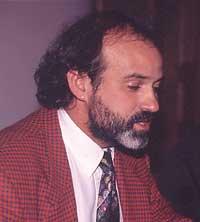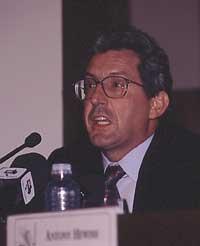Past, present and future of the universe!

Past, present and future of the universe!

Rarely do we have the opportunity to hear in this area a talk given by the Nobel Prize. On October 31, Elhuyar Kultur Elkartea offered us this opportunity on the occasion of the twenty-fifth anniversary of its foundation. I also want to congratulate Elhuyar for my part.
The anniversary celebration focused on the Nobel Prize in Physics A. It was a lecture by Hewish. In particular, he was awarded the prize for the discovery of the pulsars. This discovery is especially important for the development of theories on the evolution of stars, but A. Hewish works in the field of radio astronomy and his research has greatly influenced Cosmology. In it a topic of this last field was addressed. As his title “Past, Present and Future of the Universe” clearly indicates, he explained to us in a very pleasant way the main lines of evolution of the universe.

A. A. Hewish first introduced us to the phenomenon of the expansion of the Universe. In the third decade of this century, as a result of a very important experimental work, E. Hubble discovered that galaxies are moving away from us. In addition, its measurements show that the greater the distance to the galaxy is the velocity of distance. The direct consequence of this dependence on velocity over distance is that the distance between any pair of galaxies in the Universe is increasing, that is, that the Universe expands.
Therefore, the distribution of matter in a growing volume in the future makes the density of the Universe less and less. It is logical that reasoning should also be delayed in time. In this case we conclude that in the past the matter has been more accumulated and that the density has been much higher. The final conclusion is that at some point the matter was totally accumulated and that a big explosion called Big Bang caused the expansion that still lasts.

A is sufficient with the expansion and force of gravity that will always be against it. Hewish makes a first summary of the global evolution of the Universe. If the density of the Universe is greater than a certain value called critical density, the force of gravity will slow expansion and the Universe will begin to contract.
Matter will accumulate again until its total collapse. If the density is less than the critical value mentioned, the expansion will continue forever. The same will happen when the value of the density is a critical value, although in this case the speed of propagation will be slower.
In the 1950s there was still no further indication that the Big Bang explosion was credible. Therefore, there were also those who raised things differently. F. F. A spoke of Hoyle and his stable universe model. Hewish. Supporters of this model believe that the Universe has always had and will have the same aspect.
They also accept the expansion. Therefore, they proposed that a new matter be created to cover the large intergalactic gaps that would generate expansion. But it is not easy to determine the process, since it is never so in intergalactic space.

This last model was practically discarded when in 1963 the radiation produced by the Big Bang, called background or background radiation was detected. As the Universe expands its average temperature is decreasing, corresponding to 2.7 K, the background radiation. The radiation is spread throughout the space and due to its weakness is undetectable.
Observations with telescopes and radio telescopes also show a universe in constant evolution. In no case a stationary universe. In short, the farther we look at the stars, the more past we are looking. The Andromeda galaxy, a galaxy similar to our Milky Way, is located at 2 million light-years and the light takes 2 million years to reach us.

Therefore, we are seeing as 2 million years ago. But the resolution of the current gadgets is much greater than that, and we can see objects that are much farther away. That is why active galaxies and quasars were discovered. These objects are seen as they were millions of years ago after the Big Bang occurred, and most show violent processes that require enormous energies, characteristics of another different situation passed by the Universe.
To finish A. Hewish returned to the problem of dark matter which he had already mentioned before. The movement of galaxies and other dynamic problems make us think that there is much invisible matter in the Universe. In fact, it would only be 10% of what we can see. This is very important to decide whether the expansion of the Universe will always continue or begin to contract. The rapporteur considers that neither would all this dark matter be sufficient to curb expansion.





